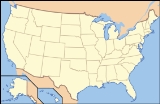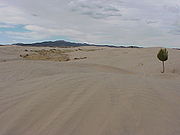
Little Sahara Recreation Area
Encyclopedia
The Little Sahara Recreation Area in Utah
is a large area of sand dunes, hills and sagebrush flats located in the west central part of the state approximately 30 miles (48.3 km) north of Delta, Utah
. It is managed by the U.S. Department of the Interior Bureau of Land Management
. A 9000 acres (36.4 km²) portion of the northwest corner of the facility has been designated as The Rockwell Natural Area and is off limits to vehicles to preserve and shelter desert plants and animals.


from about 12,500 to 20,000 years ago. The river emptied into ancient Lake Bonneville near the present day mouth of Leamington Canyon. After Lake Bonneville receded, winds transported the sand from the river delta to the current location. The dunes are still moving 5 to 9 feet (1.5 to 3 m) per year.
The sand consist of quartz
grains, with minor amounts of feldspar
, biotite
, calcite
, garnet
and magnetite
.
 Little Sahara is one of the most popular locations in the state for ATV riding. Riders can enjoy riding on 60000 acres (242.8 km²) of sand dunes, trails and sage brush flats. Sand Mountain's 700–800 foot (210 m-245 m) wall of sand challenges experienced riders and the most capable machines. Visitors can also enjoy camping, hiking and two of the world's biggest sand boxes which are areas of the dunes fenced off from vehicle and horseback riders. Though there are many campsites excellent for tent camping use of recreational vehicles and camp trailers is very popular. The area sees the highest number of visitors over holiday weekends from spring to fall.
Little Sahara is one of the most popular locations in the state for ATV riding. Riders can enjoy riding on 60000 acres (242.8 km²) of sand dunes, trails and sage brush flats. Sand Mountain's 700–800 foot (210 m-245 m) wall of sand challenges experienced riders and the most capable machines. Visitors can also enjoy camping, hiking and two of the world's biggest sand boxes which are areas of the dunes fenced off from vehicle and horseback riders. Though there are many campsites excellent for tent camping use of recreational vehicles and camp trailers is very popular. The area sees the highest number of visitors over holiday weekends from spring to fall.
 The area is home to typical Great Basin desert wildlife including mule deer, pronghorn antelope, snakes, lizards and birds of prey. Great horned owls make their home among juniper trees in the Rockwell Natural Area.
The area is home to typical Great Basin desert wildlife including mule deer, pronghorn antelope, snakes, lizards and birds of prey. Great horned owls make their home among juniper trees in the Rockwell Natural Area.
Utah
Utah is a state in the Western United States. It was the 45th state to join the Union, on January 4, 1896. Approximately 80% of Utah's 2,763,885 people live along the Wasatch Front, centering on Salt Lake City. This leaves vast expanses of the state nearly uninhabited, making the population the...
is a large area of sand dunes, hills and sagebrush flats located in the west central part of the state approximately 30 miles (48.3 km) north of Delta, Utah
Delta, Utah
Delta is a city in Millard County, Utah, United States. The population was 3,209 at the 2000 census.-Geography:Delta is located at ....
. It is managed by the U.S. Department of the Interior Bureau of Land Management
Bureau of Land Management
The Bureau of Land Management is an agency within the United States Department of the Interior which administers America's public lands, totaling approximately , or one-eighth of the landmass of the country. The BLM also manages of subsurface mineral estate underlying federal, state and private...
. A 9000 acres (36.4 km²) portion of the northwest corner of the facility has been designated as The Rockwell Natural Area and is off limits to vehicles to preserve and shelter desert plants and animals.


Geology
The Little Sahara sand dunes are remnants of a large river delta formed by the Sevier RiverSevier River
The Sevier River , extending , is the longest Utah river entirely in the state and drains an extended chain of mountain farming valleys to the intermittent Sevier Lake...
from about 12,500 to 20,000 years ago. The river emptied into ancient Lake Bonneville near the present day mouth of Leamington Canyon. After Lake Bonneville receded, winds transported the sand from the river delta to the current location. The dunes are still moving 5 to 9 feet (1.5 to 3 m) per year.
The sand consist of quartz
Quartz
Quartz is the second-most-abundant mineral in the Earth's continental crust, after feldspar. It is made up of a continuous framework of SiO4 silicon–oxygen tetrahedra, with each oxygen being shared between two tetrahedra, giving an overall formula SiO2. There are many different varieties of quartz,...
grains, with minor amounts of feldspar
Feldspar
Feldspars are a group of rock-forming tectosilicate minerals which make up as much as 60% of the Earth's crust....
, biotite
Biotite
Biotite is a common phyllosilicate mineral within the mica group, with the approximate chemical formula . More generally, it refers to the dark mica series, primarily a solid-solution series between the iron-endmember annite, and the magnesium-endmember phlogopite; more aluminous endmembers...
, calcite
Calcite
Calcite is a carbonate mineral and the most stable polymorph of calcium carbonate . The other polymorphs are the minerals aragonite and vaterite. Aragonite will change to calcite at 380-470°C, and vaterite is even less stable.-Properties:...
, garnet
Garnet
The garnet group includes a group of minerals that have been used since the Bronze Age as gemstones and abrasives. The name "garnet" may come from either the Middle English word gernet meaning 'dark red', or the Latin granatus , possibly a reference to the Punica granatum , a plant with red seeds...
and magnetite
Magnetite
Magnetite is a ferrimagnetic mineral with chemical formula Fe3O4, one of several iron oxides and a member of the spinel group. The chemical IUPAC name is iron oxide and the common chemical name is ferrous-ferric oxide. The formula for magnetite may also be written as FeO·Fe2O3, which is one part...
.
Recreation

Wildlife


